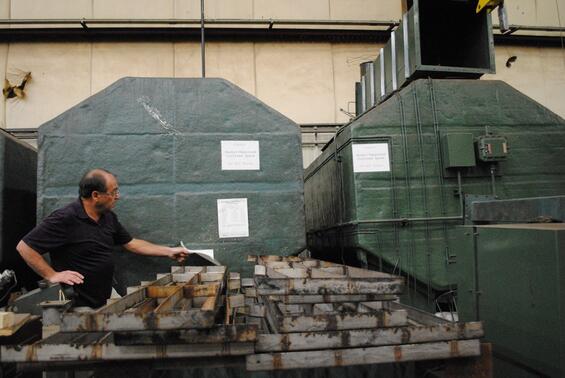Background

Shawmut corporate headquarters, West Bridgewater, MA
Shawmut laminates over 40 million yards annually on 16 laminating lines, making it the largest laminator of its kind in the U.S. The various lamination techniques historically used by Shawmut include: flame lamination – a process for bonding polyurethane foam to fabrics or films by passing the foam over an open flame and using molten foam as a binding agent; solvent-based adhesive lamination using a two-part solventbased urethane adhesive printed at very low coating weights; and thermoplastic adhesive lamination using both molten adhesives and precast adhesive webs. Shawmut laminates for a variety of industries including the automotive, medical, protective/performance wear, military, hospitality, and filtration industries.
Control and Recovery of TCE Emissions
Prior to 1990, Shawmut’s adhesive lamination process occurred within a room-temperature enclosure. The process used a two-part urethane adhesive, which contained approximately 56% TCE and 44% urethane solids by weight. The process involved applying the adhesive to a face substrate by an engraved roll. A lining substrate was then brought into contact with the adhesivecoated face material at a laminating drum. The materials were then pressed together and passed over a large-diameter drum to assure proper lamination. The finished product then proceeded to a takeup reel for removal. Throughout the adhesive lamination process, all volatile organic compounds (VOCs) were emitted without control, with hoods and blowers to minimize the exposure to employees. The company’s first TUR project involved the installation of a carbon adsorber to capture VOCs, rather than emit them. Shawmut reclaimed TCE from the adsorber and sold it back to the adhesive vendor. Over the years, the company put in significant effort to ensure capture by enclosing the lamination lines, resulting in a more efficient flow to the carbon adsorber. Because residual TCE contained in the product was hard to quantify, Shawmut decided to evacuate the product prior to inspection, resulting in the development of a method to extract the VOCs from the roll and capture them with the carbon adsorber. Shawmut continued to look at cleanup, mixing operations, and general storage as further ways to reduce usage and emissions. One example of this was the introduction of mixing/pumping stations and an enclosed cleaning and storage area that vented into the carbon adsorbers. The company also discovered that sealing the equipment hoods and monitoring the amount of TCE being removed during lamination helped increase the overall effectiveness of the carbon adsorbers.
Elimination of TCE Use in Facility

Kevin Souza with obsolete carbon adsorbers
In addition to recovering TCE emissions with carbon adsorbers, Shawmut has worked to eliminate TCE, the solvent, from the adhesion lamination process. In 1995, the company introduced a new hot-melt lamination process, which uses a 100% solid and VOC-free adhesive. In the new process, the adhesive was pre-melted, applied to a moving web, in low coating weights, in molten form. With the new process, some of Shawmut’s products transitioned easily, but other products required extensive process engineering, equipment innovation and chemical engineering before they could comply with specifications of the new “green” process. In October of 2011, the company had made sufficient progress with the new process and decided to discontinue the use of adhesive with TCE. Over the next 18 months, Shawmut worked toward moving all their products to the hot-melt line, completing the transition in March of 2013.
| Year | Adhesive | TCE (pounds) | Production Units | |||||
|---|---|---|---|---|---|---|---|---|
| In Formula | Recovered | Hazardous Waste | Emitted | Solvent | Hot Melt | Total | ||
| 2004 | 789,109 | 431,793 | 325,532 | 18,648 | 87,613 | 7,673,444 | 4,891,135 | 12,564,579 |
| 2005 | 359,570 | 198,544 | 159,937 | 10,731 | 27,876 | 6,771,782 | 5,264,378 | 12,036,160 |
| 2006 | 368,405 | 203,954 | 165,435 | 12,802 | 25,717 | 6,756,651 | 5,621,605 | 12,378,256 |
| 2007 | 198,314 | 109,385 | 82,596 | 16,747 | 10,042 | 2,676,441 | 1,527,333 | 4,203,774 |
| 2008 | 128,081 | 70,657 | 48,298 | 13,670 | 8,690 | 24,608 | 22,963 | 47,571 |
| 2009 | 40,002 | 21,868 | 14,303 | 6,383 | 1,183 | 4,500,288 | 3,536,665 | 8,036,953 |
| 2010 | 53,246 | 29,331 | 8,572 | 8,572 | 12,188 | 577,218 | 4,839,975 | 5,417,193 |
| 2011 | 28,539 | 15,547 | 9,871 | 5,062 | 614 | 424,278 | 4,367,799 | 4,792,077 |
| 2012 | 22,158 | 12,244 | 8,888 | 1,580 | 1,775 | 358,916 | 3,614,751 | 3,973,666 |
| 2013 | 3,663 | 1,857 | 1,280 | 556 | 21 | 93,728 | 3,251,319 | 3,345,047 |
Results
Over the past several years, as Shawmut worked toward the elimination of TCE, the company has had the support and assistance of the Office of Technical Assistance (OTA). OTA assisted Shawmut with the identification of safer alternatives to TCE, leading to the recovery and eventual elimination of TCE use in Shawmut’s processes, which has resulted in several benefits for the company. Shawmut saved approximately $1,000,000 per year in the solvent-based adhesive lamination process as a result of lower adhesive application weights and less waste, resulting from the implementation of better process controls. The complete elimination of TCE in 2013 has led to an additional $750,000 in annual savings, which includes savings in the maintenance and operation of the solvent recovery systems, the recovery of valuable floor space, and the handling and controls associated with hazardous waste, such as costs of material handling, hazmat supplies, engineering support, administration, and waste disposal.
Shawmut has nearly eliminated their hazardous waste; they are currently a very small quantity generator (VSQG). Before eliminating TCE, the company was a large quantity generator (LQG) and typically spent approximately $20,000 annually on hazardous waste disposal costs. In 2014, the cost was only $600, which is a savings of over 95%. OTA also provided compliance assistance to Shawmut, including TURA reporting clarification. Recently, OTA assisted Shawmut on communication with EPA concerning the company’s petition to eliminate their Title V Operating Permit, leading to a successful resolution.
Shawmut’s TUR projects have also led to an improvement in the quality of their product. Lighter coating weights and improved process controls led to a “softer and more consistent product.” The elimination of TCE in Shawmut’s products has produced a greater acceptance in the marketplace and the company is proud that they have become a “greener” company by eliminating the use of TCE in their facility.
“I want to thank the TURA program and especially OTA, for assisting Shawmut throughout this process. OTA worked alongside us to identify safer alternatives to TCE and provided guidance on the changing face of compliance here at Shawmut, including guiding our status change from a large-quantity generator of hazardous waste to a very small-quantity generator and assisting with our petition to eliminate our EPA Title V Operating Permit.”
Published 2015